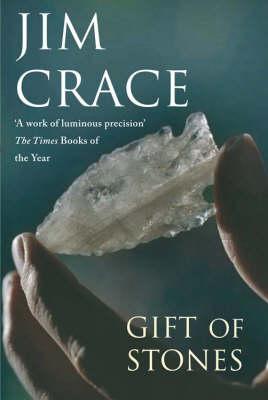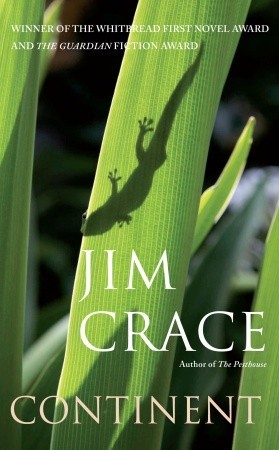Despite existing in some literary middle ground between short story collection and novel, Jim Crace’s debut, Continent (1986), won the Whitbread First Novel Award. His encore, The Gift of Stones (1988) invites no such dubiety, as it’s very much Team Novel, delivering a single narrative thread, rather than a series of shorter tales linked with a common theme.
But stories are at its heart, with the unnamed narrator recalling her father’s life, mixing her remembered experiences with speculation and the many stories he, as a storyteller, told. As a boy her father had lost a portion of his arm, but there was always a story for its loss:
He would invent tales to explain the injury. The arm was taken by a drunk and hungry traveller who mistook it for a chicken. Or it came away at his birth when the women, made impatient by their night-long vigil, tugged too hard upon it. Or it was torn free by an animal – no one knows its name. One bite.
As a result of the injury, the father grew up “like some wild plant, ragged, unattended, not much use”. In this day and age, the loss of a limb is no barrier to achievement but, where Continent took us to an imaginary land mass, and examined the effects of the known world hitting its shores, here Crace takes a step back in history, into pre-history, and narrows the tale to a small settlement at the end of the Stone Age, surrounded by an unknown world. Thus the father’s destiny was to be a stonemason, like all the other villagers.
The advantage of the father’s uselessness is that, despite being a non-working mouth to feed (“In such a place you earned respect through flint. It was the bedrock of their world.”), he is free to wander and explore. Returning with tales of the world beyond the village, of sailing ships along the coast and new rocks the likes they’ve never seen, he honed his skills as storyteller, a raconteur thrilling his audience, becoming an aide to trade.
…when he spoke he shaped the truth, he trimmed, he stretched, he decorated. He was to truth what every stoney was to untouched flint, a fashioner, a god.
The trading in knapped stone is what sustains the village; in exchanging their wares they remain fed and safe. It is also their connection to the wider world, the stories brought by passersby. This security is the titular gift of stones. Without this quality they would no doubt succumb to passing traders and raiders.
If all that the outside world needed was to pound and crush and hammer like savages then any rock would do. But once they wanted more, to pierce and slice, to cut and scrape, to remove the flesh from the inner side of pelts for making clothes, to have harpoons and arrows light and sharp enough to fly and kill, to cut back wheat with just one sickle-stroke, then they, those farmers, horsemen, fishers, wrights, could not be free of us and we were safe.
As we know from history, stone segued to bronze, and the villagers’ own complacency threatens their place in a lawless world. And here we can join the dots between the novel’s milieu and the world it arrived in with mythically drawn echoes of Thatcher’s Britain, wherein traditional industries lost out to new services, as mines and factories closed and smaller towns lost purpose. Stripped of its inspiration, Crace elevates the subject, finding a more universal view of how civilisations may decline and serves up a warning against complacency while also asking who remains to tell the tale and what of it we may believe.
As we know, the daughter is telling this tale, and we only know her father through her words, and her version of his words with their own questionable veracity. It’s a narrative device that befits the setting, that of a time before literary records. There are no scribes to capture glories, and so The Gift of Stones resembles an oral history; it’s that tale passed down through the generations, shaped and tweaked, like flint.
And the telling of the tale is wonderfully wrought, wholly consistent in its world, delivering layers of story each laced with meaning. Every simile, metaphor, and allusion is at one with nature and limited to the extent of the narrator’s world. In Crace’s Stone Age evenings may have a “rosehip sunset” and red stones can be the colour of “elderberry stain”; every such brush stroke deliberately poetic and beautiful.
The entertainment of stories, and our engagement with them, is reflected well throughout, be it the narrator’s appreciation of her father’s tales; or the villagers’ wonder at the delights beyond their acre; and perhaps even in our own enjoyment of the book itself. And a finely crafted tale, as the narrator notes, is what gets the best reactions.
Why tell the truth when lies are more amusing, when lies can make the listener shake her head and laugh – and cough – and roll her eyes. People are like stones. You strike them right, they open up like shells.
Without fictional accounts, we are left with facts. And in The Gift of Stones, facts are inconvenient truths, they are the one thing that people are afraid to face: that what we know today will one day be left behind, just as stone gave way to bronze. That our hands “made tame, secure, and virtuous by labour” are always at risk of being made idle.

